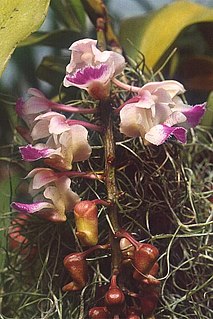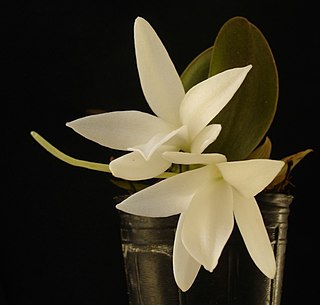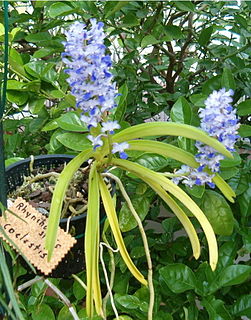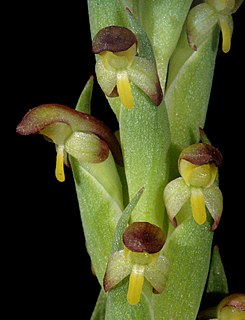
The Orchidaceae are a diverse and widespread family of flowering plants, with blooms that are often colourful and fragrant, commonly known as the orchid family.

In the botanical classification of plants, Aeridinae is a subtribe of the Tribe Vandeae whose representatives all have a monopodial growth habit and do not possess pseudobulbs.

Aerangis, abbreviated as Aergs in horticultural trade, is a genus of the Orchid family (Orchidaceae). The name of this genus has been derived from the Greek words 'aer' (air) and 'angos' (urn), referring to the form of the lip. It is the type genus of the subtribe Aerangidinae, which has recently been subsumed in the subtribe Angraecinae. Approximately 50 species in this genus are known mostly from tropical Africa, but also from the Comoro Islands, Madagascar and Sri Lanka.
The taxonomy of the Orchidaceae has evolved slowly during the last 250 years, starting with Carl Linnaeus who in 1753 recognized eight genera. De Jussieu recognized the Orchidaceae as a separate family in his Genera Plantarum in 1789. Olof Swartz recognized 25 genera in 1800. Louis Claude Richard provided us in 1817 with the descriptive terminology of the orchids.. The next step was taken in 1830-1840 by John Lindley, who recognized four subfamilies. He is generally recognized as the father of orchid taxonomy. The next important step was taken by George Bentham with a new classification, recognizing subtribes for the first time. This classification was first presented in a paper that Bentham read to the Royal Society in 1881. Then it was published in 1883 in the final volume of Genera Plantarum. The next great contributors were Pfitzer (1887), Schlechter (1926), Mansfeld (1937), Dressler and Dodson (1960), Garay, Vermeulen (1966), again Dressler (1981). and Burns-Balogh and Funk (1986). Dressler's 1993 book had considerable influence on later work.

Disperis is a genus of plants in the orchid family, Orchidaceae. It has about 78 species. Most of the species are from tropical and southern Africa, as well as Indian Ocean islands. A few are native to the tropical or the warmer subtropical regions of Asia and Malesia.

Dendrophylax is a genus of leafless neotropical orchids native to Mexico, Central America, the West Indies, and Florida. The name is from Greek δένδρον ("tree") and φύλαξ. One species, Dendrophylax lindenii, featured heavily in the book The Orchid Thief.

Rhynchostylis is a genus in the orchid family (Orchidaceae), closely allied to the genus Vanda and comprising four currently accepted species native to the Indian Subcontinent, China, Indochina, Malaysia, Indonesia and the Philippines. The name consists of a compound of two Greek elements : rhynchos 'beak' and stylis 'column' – in reference to the very broad, fleshy column of the flower. The flowers are borne in dense racemes and are noted for their intense, spicy fragrance. Although lacking in pseudobulbs, the plants have leathery leaves that are drought-resistant. These orchids grow naturally in warm, moist, shaded tropical areas and will thrive in cultivation if given consistent warmth, uniform moisture and bright, but indirect light. Hobbyists wanting to grow them will need a warm, humid growing environment with gentle air movement. They can be grown in pots, but are better grown in baskets, owing to the extreme fleshiness of their roots. Their unusually fragrant blooms often appear in the slightly cooler winter months.

The Vandeae is a large monophyletic tribe within the family of orchids.

Aerangis fastuosa, commonly known as the 'Magnificent Aerangis', is a species of epiphytic orchid endemic to Madagascar. It is widespread across Madagascar, stretching from the eastern coastal forests across to the south and along the central plateau. Aerangis fastuosa belongs to the family Orchidaceae, substribe Aerangidinae.

Brownleea is a genus of flowering plants from the orchid family, Orchidaceae native to Africa and Madagascar. Eight species are known.
- Brownleea coeruleaHarv. ex Lindl.
- Brownleea galpiniiBolus
- Brownleea graminicolaMcMurtry
- Brownleea macrocerasSond.
- Brownleea maculataP.J.Cribb
- Brownleea mulanjiensisH.P.Linder
- Brownleea parvifloraHarv. ex Lindl.
- Brownleea recurvataSond.

Pachites is a genus of flowering plants in the orchid family, Orchidaceae. It contains two known species, both endemic to South Africa. One of these, Pachites appressus, is very rare.

Angraecinae is a subtribe in the family Orchidaceae. The subtribe consists of approximately 18 genera and about 360 species. The type genus is Angraecum. Most of the genera are endemic to Africa, Madagascar and other Indian Ocean Islands, a few genera can also be found in the Americas.
Polystachyinae is a subtribe within the tribe Vandeae in family Orchidaceae. It consists of 4 genera and about 228 known species. The type genus of this subtribe is Polystachya. The group is pantropical, being native to tropical Africa primarily, but also to tropical America. Members of this group are epiphytic and are distinguished from the other subtribes in the tribe Vandeae by their sympodial growth habit and the presence of four pollinia. Pollination is mostly by small species of bees, however some species exhibit auto-pollination.

The Eriinae form a subtribe of Podochileae, a tribe of the orchid family (Orchidaceae). The name is derived from the genus Eria.

Dendrobieae is a tribe in the subfamily Epidendroideae, in the family Orchidaceae.

Diseae is an orchid tribe in the subfamily Orchidoideae. It was recognized in Genera Orchidacearum volume 2, which was published in 2001. It consisted of 12 genera in five subtribes. In molecular phylogenetic studies that were published after 1999, it was shown that Diseae is paraphyletic over the tribe Orchideae. In a classification of orchids that was published in 2015, Diseae was not recognized, but was instead placed in synonymy under Orchideae.

Coryciinae is a subtribe of orchids that has been differently defined and placed in the two classification systems that are currently in use for orchids. Genera Orchidacearum, which is currently the definitive work on orchid taxonomy, delimits Coryciinae as consisting of five genera: Disperis, Evotella, Ceratandra, Pterygodium, and Corycium, and it places Coryciinae in the mostly African tribe Diseae, along with four other subtribes: Brownleeinae, Huttonaeinae, Disinae, and Satyriinae. The genera of Coryciinae are small to medium in size and the number of species in each genus is as follows: Disperis (78), Pterygodium (19), Corycium (15), Ceratandra (6), and Evotella (1).

Zygopetalinae is an orchid subtribe in the tribe Cymbidieae with 418 species.

Erasanthe is a genus of epiphytic orchids. It contains only one known species, Erasanthe henrici, endemic to Madagascar. Two subspecies are recognized:

Disinae is a subtribe of orchids that has been differently defined and placed in the two classification systems that are currently in use for orchids. Genera Orchidacearum, which is currently the definitive work on orchid taxonomy, delimits Disinae as consisting of two closely related genera, Disa and Schizodium, and it places Disinae in the mostly African tribe Diseae, along with four other subtribes: Brownleeinae, Huttonaeinae, Coryciinae, and Satyriinae. In the classification for orchids that was published by Chase et alii in 2015, Schizodium was placed in synonymy under Disa, while Pachites and Huttonaea were transferred to Disinae. In Genera Orchidacearum, Pachites and Satyrium form the subtribe Satyriinae, and Huttonaea is the sole genus in the subtribe Huttonaeinae. The transfer of Pachites and Huttonaea to Disinae by Chase et alii (2015) was done with considerable doubt, and was based upon uncertainty about the relationships of these two genera. In 2009, a molecular phylogenetic study found only weak statistical support for a sister relationship between Huttonaea and Disa.
















